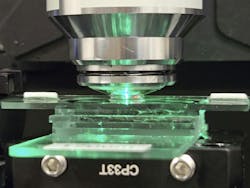Fiber-optic ‘disco ball’ manipulates individual deep brain neurons in new ways
A tiny fiber-optic “disco ball” device created by a team of Washington University in St. Louis (WashU) researchers allows neuroscientists to manipulate neural activity deep within the brain in new ways—and at unprecedented scale.
To do it, Song Hu, a professor of biomedical engineering, teamed up with Adam Kepecs, a professor of neuroscience and psychiatry. Their combined group’s device, “PRIME,” enables panoramically reconfigurable optical stimulation through a single implant—into more than 1,000 different sites.
“While fiber optics were originally developed for telecommunications, their ability to deliver light precisely into the deep brain with minimal invasiveness made them invaluable tools for neuroscience,” says Shuo Yang, a postdoctoral researcher who led the development of PRIME.
When combined with optogenetics, which uses light to control genetically modified neurons, fibers can deliver light deep into the brain to target specific neurons and turn them on or off.
PRIME: A fiber-optic device to target neurons in thousands of brain regions
How does PRIME work? “To steer light out of a fiber, we use fiber Bragg gratings, which are tiny periodic changes in the glass’s refractive index that couple light from inside the fiber (the core mode) to light that radiates outward (the radiation mode),” explains Yang. “These gratings created by laser light inside the fiber core act like micromirrors to redirect light out from specific locations of the side surface.”
The team uses laser microfabrication to sculpt microscopic gratings inside the fiber in three dimensions (3D) for precise control of both where and how light exits.
“To generate many independent emission sites, we use a multicore fiber containing more than 1,000 light-guiding cores,” says Yang. “Each core is individually patterned with laser-written gratings that determine the location and direction of light emission, which enables panoramic coverage—light projected all around the fiber’s cylindrical surface.”
By selectively launching light into different cores, researchers can dynamically reconfigure illumination patterns along the fiber, which allows them to target different brain regions via one implant.
“The most thrilling moment of this work for me was realizing we could laser-write submicrometer gratings into more than 1,000 stacked cores—each one ~2 µm,” says Yang. “At first, I wasn’t sure it was even possible because the cores are layered in depth rather than laid out flat. It’s like trying to hit a target hidden behind several others.”
Achieving this via nonlinear, multiphoton laser processes was a “true ‘aha!’ moment,” Yang says. “More broadly, it highlights the incredible potential of ultrafast lasers for 3D microfabrication and device integration.”
Simple to use/plug-and-play design
The biggest challenge the team faced was making PRIME easy and reliable for neuroscientists to use. “Aligning light into more than 1,000 microscopic cores is daunting,” Yang says. “To solve this, we developed an automated algorithm: Users simply take an image of the fiber cross-section and our software detects every core and directs light to the chosen ones.”
PRIME uses a “core-ensemble coupling” strategy, in which light is coupled into small groups of neighboring cores instead of merely one. This design reduces alignment sensitivity and manufacturing variation, which makes PRIME a plug-and-play device that can integrate seamlessly into standard neuroscience setups.
The group programmed PRIME to match the pitch and hand positions used when playing Canon in D on the piano. Credit: S. Yang, K. Yang, Q. Chevy, A. Kepecs, and S. Hu, Nat. Neurosci. (2025); https://doi.org/10.1038/s41593-025-02106-x
What does PRIME mean for optogenetics and neuroscience?
Most importantly, PRIME allows neuroscientists to ask and explore new kinds of questions. “Instead of stimulating one spot at a time, they can now shape light in both space and time to study how neighboring neural circuits interact—and how patterns of activity across the brain drive behavior,” says Yang.
The days of simply flipping neurons on and off are over—it’s now about revealing how coordinated activity gives rise to what animals see, feel, and do.
“We’re already collaborating with several neuroscience labs to apply PRIME for their studies, and interest has grown rapidly since our paper went online. While current access is through collaborations, we’re developing standardized protocols to make PRIME available to the broader neuroscience community soon,” Yang says.
The next step is to combine PRIME with fiber photometry to enable a bidirectional interface that can both stimulate neurons and record their responses. “We also plan to make PRIME wireless and wearable, because the less constrained the animal, the more natural—and meaningful—the data we can collect,” Hu adds.
FURTHER READING
S. Yang, K. Yang, Q. Chevy, A. Kepecs, and S. Hu, Nat. Neurosci. (2025); https://doi.org/10.1038/s41593-025-02106-x.
About the Author
Sally Cole Johnson
Editor in Chief
Sally Cole Johnson, Laser Focus World’s editor in chief, is a science and technology journalist who specializes in physics and semiconductors.

